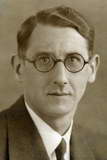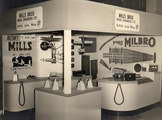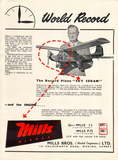Preface to Mike Harding's Mills History
Today, more than half a century after their manufacture, the model compression-ignition engines—popularly called "diesels"—made by the English company Mills Brothers (Model Engineers) Limited remain a joy to own and operate. As prized "collectables", owners are now more hungry for background information about their genesis than was the case back when there were people still alive who could supply the answers! Accordingly, we have had to fall back on accepted hear-say and dimly remembered second and even third-hand accounts.My own technical appraisals of the Mills engines on the Model Engine News web site attracted contact with Mr Micheal Harding whose father, Arnold Lewis Hardinge, had presided over engine manufacture at the Mills Bros. factory following WWII. Mike has kindly put together an account of his memories regarding the background to the Mills engines which challenges some heavy-weight folk-lore. He admits to not having his father's mechanical aptitude, however as a lecturer at Regent's College London in the area of psychotherapy and philosophy, he is well versed in the presentation of evidence. Together with the account that follows, Mike provided his remaining mementos of Mills Brothers in the form of photos, advertising leafletes, and the actual Mills patent, long though lost forever.
As you read Mike's account, consider what we do know. We can definitely state that Arnold Hardinge was the original holder of the patent under which all Mills engines were made. The patent was applied for on May 20, 1946 and as Mike says, must have been preceded by some development work. We also know that model compression-ignition engines first appeared in Europe. The Swiss Dyno 1 had been on sale as early as 1941. Plans for the home-constructed Nova 1 were published in German-occupied Holland during 1943. Plans for the Italian designed Mancini M20 appeared in Germany and France during 1944 and Allouchery made and sold diesels in France from 1945 onwards. All these pre-date the Mills patent, but there was a rather serious war on most of this time, so communication would have been scant, and as Mike suggests, independent, parallel development is not without precedent.
So keep all the above facts in mind, read Mike's account, and form your own opinions.
Ron Chernich
Brisbane, 17 June 2007.
The Original Mills History
The original Mills Bros. company manufactured track for model trains in Sheffield and owned a general model shop in High Holborn, London. My father went into business with them in the immediate post war years, and at some point—I do not know when—he bought their name and set up a small factory at 143, Goldsworth Road, Woking, in Surrey. He discontinued the production of model railway track and concentrated on the production of compression-ignition engines, There were three models, the 1.3cc, the .75cc, and the 2.4cc. As well as producing these engines, the factory also specialised in manufacturing high-precision components for companies such as Vickers, the Royal Aircraft Establishment at Farnborough, and for the Ministry of Defence. Many of these projects were one-off, experimental prototypes, which had to be manufactured to a very high specification, often using metals with inherent machining problems. My father delighted in facing such challenges, particularly if the components were particularly small. He once remarked that he considered anything bigger than a box of matches to be "very large". Although the company was successful in the production of such prototypes, it did not have the capacity to manufacture any of the few that later went into full scale production. Such contracts went elsewhere. Looking back, I would have to conclude that the time my father spent in "getting things right" rather than touting for easy contracts was not good business sense. His passion for perfection often got the better of him, and perhaps played a part in the eventual collapse of the company.
 Before looking at the development of the Mills engines, I would give something of the inventor's background. My father was born in 1906 in London. His father was German, his mother British. The family name was Neumiester. With the outbreak of the First World War his father was interned on the Isle of Man. With no one to support the family of three children, his mother took them to relatives in Germany, and my father remained there until 1937. He did not train as an engineer though was actively involved in the problems of engineering, first as an executive for the Ford Motor Company in Berlin, and then with the recording company HMV, also in Berlin. In this capacity he was both involved with the practical development of gramophones (the original Mills fuel control needle is actually a 78 rpm record needle, which could then be bought wholesale for next to nothing) and also with the recording artists.
Before looking at the development of the Mills engines, I would give something of the inventor's background. My father was born in 1906 in London. His father was German, his mother British. The family name was Neumiester. With the outbreak of the First World War his father was interned on the Isle of Man. With no one to support the family of three children, his mother took them to relatives in Germany, and my father remained there until 1937. He did not train as an engineer though was actively involved in the problems of engineering, first as an executive for the Ford Motor Company in Berlin, and then with the recording company HMV, also in Berlin. In this capacity he was both involved with the practical development of gramophones (the original Mills fuel control needle is actually a 78 rpm record needle, which could then be bought wholesale for next to nothing) and also with the recording artists.
In his executive position he arranged for many of the Jewish recording artists to have their royalties paid into British or American bank accounts. Alas, this conflicted with the NAZI's views on 'smuggling money'. This was a capital offence and he was visited in the early hours by the Gestapo with a warrant for his arrest. He asked their permission to call 'his friend', the British ambassador. After some private discussion, they suggested that he took advantage of his dual nationality at the earliest opportunity. He took their advice and left within days. Of course, my father had never met the ambassador. He later used the same ploy in the immediate post-war years when setting up his company. At the time there were immense restrictions in all areas of life. Everything was in short supply, including phone lines. Priority for these were supposed to be given to businesses, but Mills had no luck. After weeks of fruitless begging, my father wrote to the area manager, claiming that he knew of several private citizens who had phones installed ahead of businesses. A phone arrived within the week; but I am getting ahead of myself.
On his return to England, he changed the family name from Neumiester to Hardinge—to which his British mother could lay a claim. During the war he worked in a civilian capacity with the army's bomb disposal units, and it was during this time that his theoretical knowledge of engineering was put to practical use—as was his knowledge of German engineering procedures. It was then that he taught himself to use the tools of the machine shop, where his main job was to examine the fuse mechanisms taken from unexploded bombs in order to develop the equipment necessary to make them safe. As he was sometimes present when the devices were used for real, there was a certain pressure to 'get things right'. Not all of his colleagues were so successful. One of the contributors to your account of the 1.3 astutely notes the mix of metric and Imperial measures incorporated into the Mills design. I had to smile when I read this. Yes, very much my father. He certainly thought in two languages, sometimes quite deliberately, always thinking in German in an office environment as this helped him to concentrate against the background of English voices.
At the war's end my father was totally at home in the machine room. I have many memories of him working in the Mills factory at weekends, where I would wander around marvelling at the array of machinery—of course totally illegal under the Factory Act—even more so my father's habit of temporarily removing the safety guards around cutting heads so that he see exactly what was happening. But, why, as the war was coming to an end, should he invent a model aircraft engine rather than a new vacuum cleaner, or a better mousetrap? The answer is very simple: the idea just occurred to him, and then he was informed by a highly-qualified R.A.E. engineer that it could never work. So he made one. In fact, so certain was the R.A.E. engineer that it could not work, that one of the first prototypes was actually taken on a Lancaster bomber to prove that, though it may work at ground level, it would fail at high altitude. It didn't. I doubt that any diesel has ever flown higher. In short, the Mills diesel was in some ways made for a personal bet. But who actually designed it?
Here I have to contradict Henry J Nichols' assertion that the engines were the creation of '...a charming Swiss engineer who worked for Mills Engineering', who remains, as the contributor admits, nameless. My father readily acknowledged that a Swiss engineer had also invented a similar compression-ignition engine during the latter part of the war—whether before or after his own creation will probably never be established—but he knew nothing of it until well after hostilities finished. Perhaps the post-war the meeting observed by Nichols was the first encounter of the two inventors. And here some dates could be important.
The patent for the first Mills diesel was filed on May 20th 1946. The first engines had be manufactured before then, for the patent application clearly states that certain of its claims had already been demonstrated, specifically the fuel atomisation system. While the efficacy of the fuel transfer system has been doubted—and there may grounds for this—it nevertheless formed a central part of the application. The specific claim is that
As anyone who has owned a Mills will know, the 'deflector plate' is essentially a notch cut into the piston head. The patent further claims that this ensures that "the engine is easy to start". Not being an engineer—I have not inherited my father's mathematical mind—I will have to leave such technical discussions to others. But the claim that the Mills engine is easy to start would be hard to refute. It may well be worth considering if the patent's claim might have some validity in this respect alone.
Of course, I am partisan in this matter. Being born in 1944, I can offer no proof as to my father's sole invention of the Mills diesel, but I have vivid memories of him working on the dining room table, drawing with the pen and ink of the times the engineering diagrams of the various projects his company was undertaking. He certainly knew how to translate ideas into formal diagrams, which in their turn were translated by exotic machines into 'blue prints'—how many of us have ever seen such a 'blue print'?—and thus I would need some persuading that he needed another to turn an idea into a reality. I also recall my father's workshop. With the engines in full production, each one was sent on its way with a small slip of slightly oily paper which indicated the setting that should be applied to the cylinder head screw for the ideal 'flick-start'. This procedure was undertaken by Mr Philips, a lean man with a wonderful RAF moustache. Each engine was tested at his hand, and let to run for a while, just to make sure. But here lay a serious problem. The perennial problem faced by all aero modellers: sound.
 The Mills factory backed onto residential housing. While their occupants had no complaints to make with the noise of the .75 or even the 1.3, when it came to the 2.4, and the very short-lived 2.4 twin, much less a one-off 5cc, complaints were made. The 2.4 twin was designed mainly for use in model boats, and also in model racing cars, which were popular at the time, with several line-guided tracks in various parts of the country created by Model Road Racing Cars Ltd., with Blackpool being the most famous venue. However, to forestall the possibility of legal action being taken over the noise issue, my father discontinued production of the 2.4 and its possible successors. Instead he tried his hand at making an extremely small engine. I have a vague memory that it was .1 cc, but I may well be mistaken. However, the engine certainly measured no more than 1 inch in height. It was seriously small. I watched its first and last flight. One of those observing was Eddie Keil, of Keil-Kraft. Powering a plane with a wingspan of around 12 inches it took to the air and flew, and flew, and flew. I'm sure you know the feeling. Somewhere, in a field not far from Woking lies a wonderful Mills one-off. If anyone finds it, blow the dust out, add some fuel, and see it starts on the first flick.
The Mills factory backed onto residential housing. While their occupants had no complaints to make with the noise of the .75 or even the 1.3, when it came to the 2.4, and the very short-lived 2.4 twin, much less a one-off 5cc, complaints were made. The 2.4 twin was designed mainly for use in model boats, and also in model racing cars, which were popular at the time, with several line-guided tracks in various parts of the country created by Model Road Racing Cars Ltd., with Blackpool being the most famous venue. However, to forestall the possibility of legal action being taken over the noise issue, my father discontinued production of the 2.4 and its possible successors. Instead he tried his hand at making an extremely small engine. I have a vague memory that it was .1 cc, but I may well be mistaken. However, the engine certainly measured no more than 1 inch in height. It was seriously small. I watched its first and last flight. One of those observing was Eddie Keil, of Keil-Kraft. Powering a plane with a wingspan of around 12 inches it took to the air and flew, and flew, and flew. I'm sure you know the feeling. Somewhere, in a field not far from Woking lies a wonderful Mills one-off. If anyone finds it, blow the dust out, add some fuel, and see it starts on the first flick.
However, with regard to the 'who came first' question I am intrigued by the picture of the French Alouchery 1.25cc. It certainly bears a remarkable similarity to the Mills 1.3, or the Mills to the Alouchery, depending on which way you wish to view this. But both would appear to draw on the established engineering practices of the time. Many two-stroke motor cycles were created with heat-dispersing bee-hive cylinder heads and similar piston/stroke ratios. Perhaps the same formula was adopted, in miniature, on both sides of the Channel. While there is always much room for innovation, certain basic principles apply, even more so today, particularly in the arena of aircraft design—was the ill-fated Russian 'Concordski' really a copy of the Concorde, or did the Russians just come up with a similar design as a consequence of trying to solve similar problems?
The problem is an intriguing one, and addressed by such luminaries as the philosopher of science, Thomas Kuhn, in his seminal work, The Structure of Scientific Revolutions, in which he proposed the thesis that scientific advances do not progress in a linear manner, with one idea building upon another in a logical manner, but instead lurch from one paradigm shift to another as ideas suddenly change, often as the result of quite unexpected discoveries. We use both the theories and the materials of the time—someone who wanted to use a 78 gramophone needle as part of fuel nozzle would not have much luck today. While I am so impressed by all the thought and research that has gone into the account of Mills' development by the various contributors, there will always be imponderables that I doubt will ever be resolved. Why shift from one metal to another? Maybe to take account of what was available at the time—in the bleak post-war years when model aircraft engines were classified as toys and did not get any priority of supply—one worked with what one could get. Or maybe just as an experiment that worked.
There was, however, one Mills experiment that did not work. Being very familiar with the principle of the V1 'doodle-bug', my father developed a resonating tube attachment to the air-outlet of a 1.3, so that it sucked in the maximum amount of an air/fuel combination. Yes, I know that this idea has been around for a while, but my father tried this out in the very early 1950s. Let us say that, in his experiment, the 1.3 engine substantially exceeded its design specification for several seconds before dissolving into its different parts with remarkable alacrity. That was one Mills engine that would never start again on the first flick.
Michael Harding,
London, 23 November 2006
| Links to Mills engine reviews: | .75cc |
| 1.3cc | |
| 2.4cc | |
 Model Engine News Home
Model Engine News Home
This page designed to look best when using anything but IE!
Please submit all questions and comments to
[email protected]




